The layout of electrical circuits and their components are shown as diagrams made up of symbols and connecting lines. Being able to read a circuit diagram is important when trying to trace and correct a fault in an electrical system. However, all manufacturers do not use the exact same symbols, codes or terminal numbers, but for you to get a successful beginning at reading wiring diagrams, it is best to follow one common system. The system described here is based on the European DIN standard that generally has current flowing from top (Terminal No.30) to the bottom earth (Terminal No.31) and from left to right.
Refer to the manufacturer's service manual for specific details on how to read a particular circuit diagram.
Note:
For training and testing purposes diagrams and information is available from automotive technical manuals.
A circuit diagram (also known as an electrical diagram or electronic schematic) is a pictorial representation of an electrical circuit. It shows the different components of the circuit and the power and signal connections between the devices. Arrangement of the components and interconnections on the diagram does not usually correspond to their physical locations in the finished device.
Unlike a block diagram or layout diagram, a circuit diagram shows the actual wire interconnects being used (although the picture does not have to correspond to what the circuit actually looks like).
The individual components shown on schematic wiring diagrams can be identified by a ‘Group’ code and also by a number.Then all similar items are described by the same ‘Group’ letter, e.g. assemblies i.e. Airbag, (driver) are identified by the letter ‘A’, switches ‘S’, all fuses are identified by the letter ‘F’. The number or mathematical figure after the letter will identify the circuit to which that fuse belongs to. Light bulbs are given the letter ‘E’, motors ’M’ and all relays ’K’, again, the number after the letter will identify the circuit to which that component belongs to The full list of these is available in the Technical support Information.
The colours of the individual connecting wires can be identified by letter code that may be an English or German language abbreviation of the actual wire colour. The principal differences are;
The full list is available in the Technical support Information.
The example wiring diagrams, beginning on page 17 are those of a Volkswagen® Golf 1.4 petrol 1997-06 engine code AHW. This first diagram is broadly representative of range of manufacturer’s schematic diagrams. A special feature of this diagram is the terminal identification code ‘X’. This terminal is the equivalent of terminal No.75 (accessories) this means that it is live with the ignition on but it is switched off during engine ‘cranking’. This is to retain maximum battery voltage for engine cranking.
Some of the symbols used in these diagrams are not strictly to DIN standard, but instead they are a pictorial representation of the individual components, e.g. the dim lamps are indicated differently to the main beams. This is the system used by Autodata® and it is designed help you to ‘read’ or interpret diagrams from all motor manufacturers.
The following diagrams in this unit are an attempt to ‘lift’ or highlight individual circuits from an overall diagram. You should study each diagram carefully and then, when you feel confident, go further and practice locating and tracing these circuits in other manufacturer’s similar diagrams. Remember, the aim of this exercise is for you to have the ability to develop and construct these circuits yourself.
The purpose of the terminal designation system for automotive electrical systems is to enable correct and easy connections of the conductors to the various devices especially in the event of repairs and equipment replacement.
DIN* 72552 is a DIN standard for Automobile electric terminal numbers, standardizing almost every terminal in an automobile with a number code.
If the number of terminal designations is not sufficient (multiple-contact connections), the terminals are consecutively numbered using numbers or letters whose representations of specific functions are not standardized.
Terminal Designations: (Excerpts from DIN Standard 72 552), these terminal designations do not identify the conductors, because device with different terminal designations can be connected at the two ends of each conductor. If the number of terminal designations is not sufficient (multiple-contact connections), the terminals are consecutively numbered using numbers or letters whose representations of specific functions are not standardized.
Terminal |
Definition |
|
15 |
Switched + downstream of battery (output of ignition/driving switch) |
|
Battery |
||
30 |
Input from + battery terminal, direct |
|
31 |
Return line to battery - battery terminal or ground, direct |
|
Turn Signal Flasher |
||
49 and 49a, 49b and 49c etc. |
All terminal no’s 49 have to with the turn signal indicators |
|
Starter |
||
50 |
Starter control, ignition switch to the starter switch |
|
54 |
Brake lamp |
|
Lighting |
||
55 |
Fog lamps |
|
56(a, b) |
Headlamp system |
|
56a |
High beam and Main beam indicator lamp |
|
56b |
Low beam |
|
58 |
Side-marker lamps, tail lamps, license-plate lamps and instrument-panel lamps |
|
58L |
Side-marker lamp, left |
|
58R |
Side-marker lamp, right |
|
Alternators and voltage regulators |
||
61 |
Alternator charge indicator light |
|
Switching Relay |
||
85 |
Output, actuator (end of winding to ground or negative) |
|
86 |
Start of winding |
|
87 |
Output to the load from terminal 30 |
|
87a |
Normally closed contact |
|
*DIN “Deutsches Institut für Normung” is the German national organization for standardization and is that country's ISO member body.
Additional information is available from the automotive technical manuals.
Electrical circuits require connections to assemble or join the power supply to the desired load. Complex circuits will have switches, fuses, possibly relays etc. and all the connectors and terminal connections on the live and earth sides of these circuits. Circuits in the vehicle are subjected to the stresses of vibration moisture and temperature change also the possible corrosion by corrosive fluids and gases. Vibration and movement due to thermal expansion also cause small movement that result in friction between any connectors that are simply clamped together.
Therefore, electrical connectors must provide as easy a path as is possible for the electrons to leave one side of the connection and enter the adjoined connector. The connector must also provide adequate electrical insulation for the current flowing through it and it must prevent entry of moisture and dirt.
Connections must also be designed so that they can be readily connected or disconnected and yet have a secure locking system.
Electrical connections should not be dismantled and reassembled unless it is absolutely necessary, because each movement increases the risk of the frictional resistance affecting the quality of the surface to surface electrical contact.
It should not be possible to pair incorrect connectors/connections together as the implications of this could be most serious, the greatest dangers being short circuits and fire!
Modern vehicles use a number of electrical connectors to join sections of the vehicle harness to vehicle system components. Maintaining proper and safe function of these connectors is very important as any corrosion that occurs in or on them can cause a reduction in voltage and thus a system problem due to insufficient voltage in a particular system. Poor connections are often the cause of many automotive electrical system faults because a faulty connection can increase current draw and have an adverse affect on vehicle system operation.
They are generally water "resistant" but not "waterproof" and the use of a pressure washer (particularly if solvents are used in the washing process) directly on them should be avoided as this can start the deterioration process.
Some connectors (terminal ends) are gold coated (plated) in order to reduce potential oxidation corrosion and therefore provide a better long term electrical connection between the items being connected together. Do not mix gold coated and tin coated connections together as the combination of the different metals will cause electrolysis, which will then damage the electrical conductivity of the connection.
Relays are switches that are turned on and off by a small electrical current. Inside a relay is an electromagnet. When a small current energizes this electromagnet, it attracts an armature blade and closes contact points. The large current that the relay is designed to switch “on or off” can then flow across these points. As long as the small switching current flows through the relay coil the much larger current will flow through its contact points.
The function of a relay in the lighting circuits is to reduce the current demand on the control switch.

These contacts can be either normally-open, normally-closed, or change-over contacts.
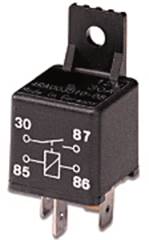
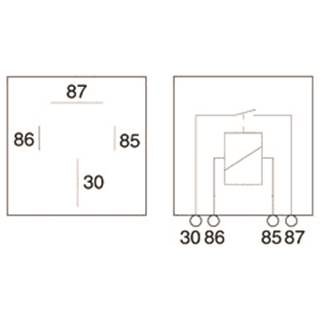
Pin No. |
Designation |
Description |
85 |
Switching relay |
Earth (end of winding to ground or negative) |
86 |
Switching relay |
Positive (start of winding) |
87 |
Switching relay |
Output (to consumer eg: driving lamp) |
87a |
Switching relay |
Alternative output (1st output, break side) |
30 |
Battery |
Positive supply (Input from + battery terminal, direct) |
Solenoid definition: linear movement from an electrical signal.
The modern starter motor is an example of where a solenoid switch, works in a similar way to a relay. It is used as a switch where very high amperage is required to start the vehicle.
When low-current power from the lead-acid battery is applied to the solenoid usually through a key switch, its movement (caused by the magnetic effect acting on its centre component) pulls out a small pinion gear on the starter motor's shaft and meshes it with the ring gear on the flywheel of the engine.
The solenoid also closes high-current contacts for the starter motor and it starts to run.
If the engine starts the key switch is released, the solenoid is de-energised and a spring returns in to the rest position thereby disconnecting the supply from the starter motor and pulling the small gear back off the starter gear.
Relay function; covered in 4.1
The socket mentioned is the common 12N TYPE. This socket is coloured black and houses 7 pins which are numbered 1 to 7 and need to be connected using the correct wiring destinations as follows.
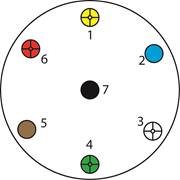 |
|
Front view of trailer socket on vehicle.
Pin |
Cable Colour |
Function |
Terminal |
1. |
Yellow |
Left turn signal |
L |
2. |
Blue |
Fog lights |
54G |
3. |
White |
Earth return |
31 |
4. |
Green |
Right turn signal |
R |
5. |
Brown |
Right hand side light |
58R |
6. |
Red |
Brake lights |
54 |
7. |
Black |
Left hand side light |
58L |
Note: Refer to manufactures fitting instructions at all times. If fitting a trailer socket on a vehicle that has a “can bus” system it is important to use the manufactures trailer socket as this will comply with the necessary requirements for that vehicle.
Covered in next section
Practical Task
Please refer to your instructor for additional information, which is available from the automotive technical manuals. Examples of in section 10.1
Component |
Circuit Symbol |
Function of Component |
On-Off Switch |
|
SPST = Single Pole, Single Throw. |
2-way Switch |
|
SPDT = Single Pole, Double Throw. |
Dual On-Off Switch |
|
DPST = Double Pole, Single Throw. |
(DPDT) |
|
DPDT = Double Pole, Double Throw. |
The following are some examples of the symbols used in circuit diagrams. The actual layout of the components is usually quite different from the circuit diagram.
Wires and Connections |
||
Component |
Circuit Symbol |
Function of Component |
Wire |
|
To pass current very easily from one part of a circuit to another. |
Wires joined |
|
A 'blob' should be drawn where wires are connected (joined), but it is sometimes omitted. Wires connected at 'crossroads' should be staggered slightly to form two T-junctions, as shown on the right. |
Wires not joined |
|
In complex diagrams it is often necessary to draw wires crossing even though they are not connected. I prefer the 'hump' symbol shown on the right because the simple crossing on the left may be misread as a join where you have forgotten to add a 'blob'! |
Power Supplies |
||
Component |
Circuit Symbol |
Function of Component |
Cell |
|
Supplies electrical energy. |
Battery |
|
Supplies electrical energy. A battery is more than one cell. |
Fuse |
|
A safety device which will 'blow' (melt) if the current flowing through it exceeds a specified value. |
Earth |
|
A connection to earth. It is also known as ground. |
Output Devices: Lamps, Motor. |
||
Component |
Circuit Symbol |
Function of Component |
Lamp (indicator) |
|
A transducer which converts electrical energy to light. This symbol is used for a lamp providing illumination, for example a car headlamp. |
Motor |
|
A transducer which converts electrical energy to kinetic energy (motion). |
Switches |
|
||||
Component |
Circuit Symbol |
Function of Component |
|
||
On-Off Switch |
|
SPST = Single Pole, Single Throw. |
|
||
2-way Switch |
|
SPDT = Single Pole, Double Throw. |
|
||
Dual On-Off Switch |
|
DPST = Double Pole, Single Throw. |
|
||
Reversing Switch |
|
DPDT = Double Pole, Double Throw. |
|
||
Resistors |
|||||
Component |
Circuit Symbol |
Function of Component |
|||
Resistor |
|
A resistor restricts the flow of current. |
|||
Variable Resistor |
|
This type of variable resistor with 2 contacts (a rheostat) is usually used to control current. Examples include: adjusting dash panel brightness. |
|||
Variable Resistor |
|
This type of variable resistor with 3 contacts (a potentiometer) is usually used to control voltage e.g. fuel gauge. |
|||
Meters and Oscilloscope |
||
Component |
Circuit Symbol |
Function of Component |
Voltmeter |
|
A voltmeter is used to measure voltage. |
Ammeter |
|
An ammeter is used to measure current. |
Ohmmeter |
|
An ohmmeter is used to measure resistance. |
Stop or brake lights are red lights fitted to the rear of the vehicle. According to the DIN 72552 they are number “54”. They are usually incorporated in the taillight cluster although many vehicles have a higher additional stop light mounted on top of the boot lid or on the rear window called a high-level stop lamp (H 85 in diagram).
The stop lights are activated whenever the driver operates the foot brake to slow or to stop the vehicle.
This schematic diagram shows the brake light circuit, Figure1 above. Switch S13 is the brake pedal switch and the circuit is protected by fuse F13 which is 10 amps.
For motor vehicles and trailers, two red tail lamps operate when the headlight switch is in the park position and the headlight position. According to the DIN 72552 they are number “58”. The two lights are located close to the widest points of the vehicle so that the vehicle width can be seen by other road users. The bulbs are connected in parallel to each other so that the failure of one filament will not cause total circuit failure. A number plate illumination lamp is usually connected in parallel to the tail lights and operates whenever the tail lights are on.
This schematic diagram shows a conventional parking/side light circuit . The circuit is protected by fuses F4, F22, F23 and is switched through S3. (note the 58 on the switch contacts).
Modern headlights are electrically operated, positioned in pairs, one or two on each side of the front of a moving vehicle. According to the DIN 72552 they are number “56a and 56b” A headlamp system is required to produce a low and a high beam, which may be achieved either by an individual lamp for each function or by a single multifunction lamp. High beams (called “main beams” or “full beams” or “driving beams” in some countries) cast most of their light straight ahead, maximizing seeing distance, but producing too much glare for safe use when other vehicles are present on the road.
The schematic diagram on page 19 shows a conventional headlamp circuit (Terminal 56a and 56b on light switch) All bulbs are fused independently. Fuse numbers F18. F19, F20 and F21 are used.
You will notice that the dim circuit (T.56b) remain on with the headlights.
Components M35 and M36 are headlamp adjustment motors.
Headlights must be kept in proper alignment (aim) and condition according to the NCT requirements for Headlamp Condition and Aim, Aux Lamps Condition and Aim
 Fog lights are used with other vehicle lighting in poor weather such as thick fog, driving rain or blowing snow. Because fog is made up of water droplets suspended in the air it can reflect headlights back into your eyes at night. In such conditions, fog lights can help drivers see further ahead and illuminate the road’s edges at reasonable speeds and are used with “park” lights instead of headlights.
Fog lights are used with other vehicle lighting in poor weather such as thick fog, driving rain or blowing snow. Because fog is made up of water droplets suspended in the air it can reflect headlights back into your eyes at night. In such conditions, fog lights can help drivers see further ahead and illuminate the road’s edges at reasonable speeds and are used with “park” lights instead of headlights.
Fog lights will normally be wired with a relay. They may be wired to work only with park lights and to turn off when headlights are used.
The schematic diagram on the following page shows a conventional fog light circuit. According to the DIN 72552 they are number “55”. The front lamps (E14 and E15) are switched by relay (K2). The earth for this relay is through the headlight filament which means that the fog lamps will only operate when the headlights are off. Fuse (F3) protects the relay and fuse (F36) protects the lighting circuit.
The reversing lights are white lights fitted to the rear of a vehicle. They provide the driver with vision behind the vehicle at night and also alert other drivers to the fact that the vehicle is to be reversed.
When the ignition switch is on and the vehicle is placed in reverse gear current flows from the battery, through the ignition switch, to the closed reversing light switch on the transmission.
Electrical current flows across the closed switch to the reversing lights and then returns to the battery by the earth return system.
Driving lights are used to supplement vehicle headlight systems. The driving lights are fitted to the front of the vehicle and provide higher intensity illumination over longer distances than standard headlight systems. NCT regulations specify the limitations in relation to the positioning of driving lights.
There are many types of driving lights available. They come in different sizes, shapes and varying bulb wattage.
The turn signal indicators are visual signalling devices to indicate the intention to turn. Once they are activated, they continue until the switch is cancelled either by the operator or by a cancelling mechanism in the switch. The cancelling mechanism operates after a turn has been completed and the steering wheel is returned to the straight ahead position.
The circuit consists of:
If the indicator switch is turned to indicate a right-hand turn, current from the battery flows through the fusible link to the ignition switch, where it is directed through a fuse to the flasher unit.
Practical Task
This is a practical task. Please refer to your instructor for additional information, which is available from the automotive technical manuals.
Practical Task
This is a practical task. Please refer to your instructor.
Practical Task
This is a practical task. Please refer to your instructor for additional information, which is available from the automotive technical manuals. Examples of in section 10.1.
In automotive systems the term “bus” can connect several control units or devices together over the same set of wires. A comparison can be made to a highway with two-way traffic and traffic emerging onto the highway from different locations. Access to the highway is controlled by traffic lights (can-bus).
This system is referred to as a Controlled Area Network BUS or CAN BUS. “CAN” stands for Controller Area Network meaning that control units are networked and they interchange data.It uses two thin wires to connect, or multiplex, all the control units and their sensors to each other. The advantage of a multiplex network is that it enables a decreased number of dedicated wires for each function and therefore a reduction in the number of wires in the wiring harness, reduced system cost and weight, improved reliability, serviceability and installation. In addition, common sensor data, such as vehicle speed, engine temperature, etc. are available on the network, so data can be shared, thus reducing the number of sensors. Also, networking allows greater vehicle content flexibility because functions can be added or modified through software changes.
A diagnostic tool can be connected to the CANBUS to extract operational information to assist in diagnosis and fault finding.
Even the most basic vehicles include many electronically controlled systems. If each electronic system had its own ECU, harness and sensors, the weight of the added components would negate any efficiency it provided. A vehicle’ multiple electronic systems could require over 1.6 Kilometres of insulated wiring, consisting of around 1000 individual wires and many terminals.
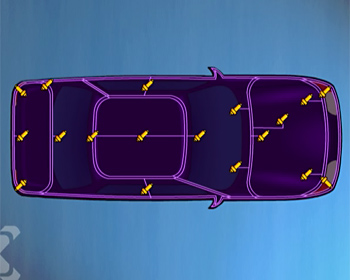
One solution to the problem is the use of a system that integrates sensors into a common wiring harness by combining all the individual systems, where possible, into a multiplexed serial communications network, so they can share the information. An added advantage is that it saves weight as it allows different systems to share sensors and reduces complexity of stand-alone systems.
Practical Task
This is a practical task. Please refer to your instructor for additional information, which is available from the automotive technical manuals.
A lamp bulb consists of a fine coil of tungsten wire, called a filament, enclosed in a clear glass envelope from which all air has been removed. Passing a current through the filament raises its temperature to a white heat and causes it to give off an incandescent light. Removing air from the glass envelope prevents oxidation of the filament when it is in operation and increases the filament life.

In high wattage bulbs, particles of tungsten can boil off the filament, even though the air is removed and eventually cause filament failure. To prevent this, the glass envelope is filled with an inert gas - such as argon - which does not react with the tungsten and this slows the boiling off of the filament. In some applications special coated bulbs are fitted, this helps prevent “yellowing” of plastic lenses.
All manufactures have procedures for removing and fitting bulbs these should be followed at all times. When fitting a halogen bulb is important not to contaminate the surface of the bulb with your hand as this will result in premature failure of the bulb. The focusing of the headlights is also advisable after fitting new headlight bulbs to ensure they are properly aligned to current NCT regulations.
All bulbs have letters and numbers stamped on the bulb which indicate the power consumed by bulb operation at the nominal operating voltage.
For instance, in a 12V/21W bulb the filament will consume 21 watts of power when 12 volts is applied across the filament.
While the wattage is not necessarily an indication of light output, it can be generally assumed that the higher the wattage, the greater the light output will be. If a higher wattage bulb is inserted than what is recommended this could lead to more heat been generated and the possibility of a fire starting.
The common bulbs used in automobiles are:
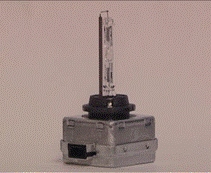
High Intensity Discharge or HID lights can be recognized by their extremely bright white or bluish light. They provide the motorist with better illumination than other types of lights. HID lights improve visibility. Drivers using HID lights are able to see the road ahead for approximately 100 meters, compared to about 60 meters for a halogen system.
In comparison with halogen lights, HID headlights can be up to 3 times brighter, are more efficient in converting electrical energy into light energy, have a longer service life and the light colour is whiter or closer to daylight.
They operate on a gas discharge bulb system and consist of a light, bulb, ballast and special high voltage circuitry. HID headlights systems do not use a filament in the bulb. They have the inert gas Xenon inside the bulb, with two electrodes that have an air gap between them in a glass tube. A high voltage is applied between the electrodes. This causes an arc to form, which vaporizes the gases and solids so they emit a bright light. The voltage required to strike and maintain the arc is very high - typically up to 20, 000 volts. Therefore when workings on these systems refer to manufactures procedures at all times.
Practical Task
This is a practical task. Please refer to your instructor.
Please refer to the current NCT reference manual, item No’s 26 to 34 inclusive for NCT requirements for Passenger Vehicle lighting systems.
Practical Task
This is a practical task. Please refer to your instructor.
Practical Task
This is a practical task. Please refer to your instructor.
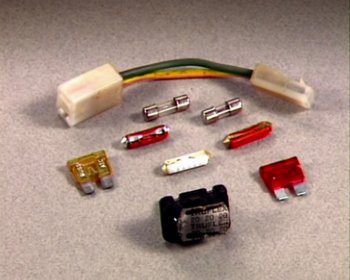
Fuses and circuit breakers are designed to break the circuit if current flow is excessive. The most common kinds are fuses, fusible links and circuit breakers. They are all rated in amperes. Their ratings are usually marked on them. It is important to fit the correct size of fuse. To small a rating will not allow enough current to flow in the circuit and too large a rating may not protect the circuit properly.
Fuses are typically used in lighting and accessory circuits where current flow is usually moderate. Changing the wattage of the bulb i.e. (incorrect bulb type) will alter the current required. If a higher wattage bulb is inserted this could lead to over loading of the electrical system and the possibility of a fire starting.
A fusible link is typically placed near the battery and, except for the starter motor; it carries the current needed to power an individual circuit, or a range of circuits.
Objective
Correctly strip an electrical wire and connect a solderless connector.

3 videos to help deliver section
Whenever you perform a task in the workshop you must use personal protective clothing and equipment that is appropriate for the task and which conforms to your local safety regulations and policies. Among other items, this may include:
If you are not certain what is appropriate or required, ask your instructor.
Use a headlamp adjuster unit to aim headlights.
Whenever you perform a task in the workshop you must use personal protective clothing and equipment that is appropriate for the task and which conforms to your local safety regulations and policies. Among other items, this may include:
Make sure that you understand and observe all legislative and personal safety procedures when carrying out the following tasks. If you are unsure of what these are, ask your instructor.
Check and change a headlight bulb.
Whenever you perform a task in the workshop you must use personal protective clothing and equipment that is appropriate for the task and which conforms to your local safety regulations and policies. Among other items, this may include:
Make sure that you understand and observe all legislative and personal safety procedures when carrying out the following tasks. If you are unsure of what these are, ask your instructor.
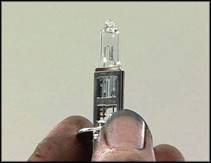
Check and change an exterior light bulb.
Whenever you perform a task in the workshop you must use personal protective clothing and equipment that is appropriate for the task and which conforms to your local safety regulations and policies. Among other items, this may include:
Make sure that you understand and observe all legislative and personal safety procedures when carrying out the following tasks. If you are unsure of what these are, ask your instructor.
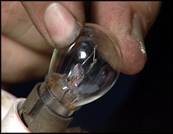
Check peripheral lighting systems.
Whenever you perform a task in the workshop you must use personal protective clothing and equipment that is appropriate for the task and which conforms to your local safety regulations and policies. Among other items, this may include:
Make sure that you understand and observe all legislative and personal safety procedures when carrying out the following tasks. If you are unsure of what these are, ask your instructor.
Source: http://local.ecollege.ie/Content/APPRENTICE/liu/hvm_notes/M7U1.doc
Web site to visit: http://local.ecollege.ie
Author of the text: indicated on the source document of the above text
If you are the author of the text above and you not agree to share your knowledge for teaching, research, scholarship (for fair use as indicated in the United States copyrigh low) please send us an e-mail and we will remove your text quickly. Fair use is a limitation and exception to the exclusive right granted by copyright law to the author of a creative work. In United States copyright law, fair use is a doctrine that permits limited use of copyrighted material without acquiring permission from the rights holders. Examples of fair use include commentary, search engines, criticism, news reporting, research, teaching, library archiving and scholarship. It provides for the legal, unlicensed citation or incorporation of copyrighted material in another author's work under a four-factor balancing test. (source: http://en.wikipedia.org/wiki/Fair_use)
The information of medicine and health contained in the site are of a general nature and purpose which is purely informative and for this reason may not replace in any case, the council of a doctor or a qualified entity legally to the profession.
The texts are the property of their respective authors and we thank them for giving us the opportunity to share for free to students, teachers and users of the Web their texts will used only for illustrative educational and scientific purposes only.
All the information in our site are given for nonprofit educational purposes